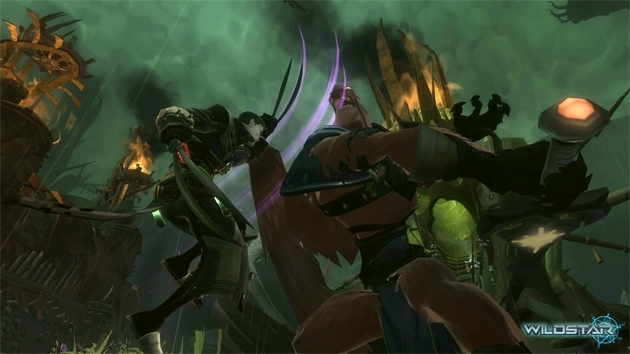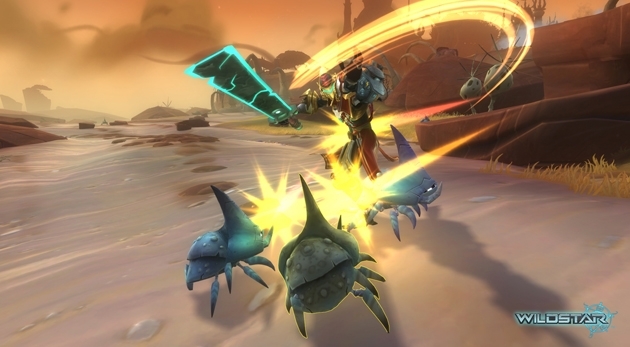WildStar: Lunch with Da Gaffer Pt 3
Carbine's Jeremy Gaffney discusses dynamic content, add-ons and social tools.

How are you going to curate add-ons?
I think a lot of that is best left to the free market. As soon as we start saying ‘This add-on’s great, use this one instead of that one,’ danger lies that way, and so I’d rather have that stuff, in general, happen through a third party.
 One of the interesting challenges is there’s a dynamic that exists among the games that have done UI modding – which is not a ton of them, it’s very few – and notice what a correlation there is between games that allow UI modding and successful games. Only three or four games have done UI modding well, I would argue, and they’re all successful. There are a million games that have not done it, and many of them are unsuccessful. So it’s not ‘do UI modding, your game wins,’ but I do think there’s a correlation or causation.
One of the interesting challenges is there’s a dynamic that exists among the games that have done UI modding – which is not a ton of them, it’s very few – and notice what a correlation there is between games that allow UI modding and successful games. Only three or four games have done UI modding well, I would argue, and they’re all successful. There are a million games that have not done it, and many of them are unsuccessful. So it’s not ‘do UI modding, your game wins,’ but I do think there’s a correlation or causation.
One of the interesting aspects of that is which UI mods to appropriate into your game proper, and then how do you compensate people for doing it? Because it’s not fair to take someone’s hard work they put in, maybe they have a great mod, maybe they’re even getting clickthrough benefits. And then we bring it in the game, and removed all the awesome stuff you did. And paying people is hard, because international is tricky. It’s the reason why volunteer programs don’t exist anymore for all these games, because if someone’s doing free work for you then class action lawsuits follow rapidly.
What you do ethically as a developer, what’s fair, and what you can do legally, that’s a tricky question.
What happens if someone creates an add-on that you don’t want in your game?
Jon [Wiesman] runs the UI side of things for us. His mentality is that it’s on us if we provide the ability to make an add-on that reduces the fun of the game. Because theoretically, anything that you could do with an add-on, if you’d hacked the client, you could have managed. And so, if you’ve got something that can be made that trivializes combat, well someone’s going to hack your game to get that anyway.
Some of the tricky parts are we do lots of UI puzzles, for instance, some quests are a little timing puzzle to play. Seeded in among a bunch of other things they’re fun, but you can probably trivially make a mod which solves these things. Which philosophy wins: make sure you can’t trivialize interesting parts of the game, or let users play the way that they want to play? That’s been interesting all the way through beta, and it’s going to get more interesting in live.
Jon’s been very open about it. He makes sure there aren’t developer commands to the UI – all of our stuff is written using the same UI modding system.
Threat meters are a good example. That’s a fundamental UI mechanic that the UI in most games does not show. Why make a fundamental system that you need to know during raiding, but there’s no in-game UI for it. Now you make people have to mod if they want to raid. Why did you have to do that as a developer? I actually don’t know. You either make it a compelling system and then give an interface to it yourself, or don’t make it at all.
WoW’s flip-flopped in both directions. It was completely unrevealed, then people made mods for it, then they effectively removed the threat aspects of it. They simplified the game to get rid of the mod, and I’m not sure if that was the right choice.

In WoW, it used to be that there was a fine line of threat, but now bosses stick to the tank like glue.
 Here’s the design problem I would guess they were trying to solve. The thing wasn’t in the UI, so it’s emergent gameplay, in the way that a lot of Ultima Online was based on bugs that turned into combat mechanics. It’s not fun to not attack, and the optimal way to play if you’re a mage, is watch the timer until the tank has threat, blast away, then go into recovery mode.
Here’s the design problem I would guess they were trying to solve. The thing wasn’t in the UI, so it’s emergent gameplay, in the way that a lot of Ultima Online was based on bugs that turned into combat mechanics. It’s not fun to not attack, and the optimal way to play if you’re a mage, is watch the timer until the tank has threat, blast away, then go into recovery mode.
It sucks in a couple of ways – the optimal way to play is not to, but I’m a damage class, I enjoy doing damage. If there are no phases of combat, or if the whole thing is mashing my optimal rotation, then that’s not fun either. That’s why you see so many boss mechanics in the game that exist to disrupt the rotation, so you have to use a slightly different rotation at slightly different times. It’s kind of obtuse, and it’s not really fun – it’s only fun in the ‘hit the button for the pellet’ way.
I understand the dance that they did with those systems, and I’m glad we’ve gone a different path, so that we get to find our own little path of trying to balance it all out.
How much are you going to use the big meteor-crash plug and sockets stuff in the persistent world?
It’s tricky, because persistent implies permanent – they happen once, and after that they’re not dynamic any more, they’re just static, and no-one ever gets to change them. I haven’t really seen a true persistent thing – the closest thing you get is player towns and player housing, where it’s mostly persistent.
We did a ton early on, maybe two or three years ago where it was all about dynamic world, pre-RIFT for instance. RIFT’s shtick was the dynamic invasions. We were like ‘Haha, those wimps, we not only have dynamic invasions, but a spaceship will crash in the middle of a field, there’s a new dungeon where its hull is, the guards go out, they find plugs and they build camps, the camps have NPCs that you can rescue, all this kind of stuff.
 All that stuff is still in the game, but we don’t hype it. And the reason we don’t hype it is that when we bring in alpha testers, people don’t know it’s dynamic. You bump into the spaceship and, as far as you’re concerned, you consume content while you’re levelling. You’re not levelling in an area for long enough to see four spaceships crash. If you were there in the first ten seconds you’d see it fly out of the sky, hit the ground and the guards come out. Every moment for the next four hours the event is there, and after that you see the static thing.
All that stuff is still in the game, but we don’t hype it. And the reason we don’t hype it is that when we bring in alpha testers, people don’t know it’s dynamic. You bump into the spaceship and, as far as you’re concerned, you consume content while you’re levelling. You’re not levelling in an area for long enough to see four spaceships crash. If you were there in the first ten seconds you’d see it fly out of the sky, hit the ground and the guards come out. Every moment for the next four hours the event is there, and after that you see the static thing.
So you only got those benefits on replay, when you make your second or third character in an area. And even then, you have to put big shiny flashy signs on everything to say ‘this is dynamic’ and players didn’t give a crap. They just wanted to get through the damn level so they can get up to cap, so they can do the cool thing they want to do.
It can also be a distraction. I was supposed to kill a bunch of wolves in this field, and there’re now fewer wolves because the guard camps are killing them. So we thought it was cool, dynamic and immersive and they were ‘No, crap, screw that.’
We still do a bunch of that. Most of them we’ve tucked into discovery, so at least you have players initiating it. And so, when a dungeon entrance rumbles up out of the ground, at least the player who clicked it knows that they caused it. And we do some of the bat-signal stuff to say ‘here’s the thing you can only do rarely.
More than that, we do things that interact well with the world around them. Most interesting of these is a blood altar that pops up and now if you kill enough monsters nearby you get a magic sword. That works in any area, doesn’t matter what monsters you kill near it, you get the added benefit of doing all the quests and scanning you were already doing in the area and it’s now giving you a new thing to do.
It’s nice having the dynamic events in-game, but we don’t do a ton, and we won’t really have it as a sticker on the side of the box. One issue we struggle with is we don’t have one big thing; we have a host of big things. If we were to only mention paths, then people would get the game on a level, but it would also be a lie, because paths is only a tenth of what we’re doing in the game that’s different.
It’s like when we talk about raiding, it’s one of four elder games that we have, verses solo story dungeons for the solo crowd, or the warplots or that other kind of stuff. And it’s tricky because, with the more information you provide, you can dilute your own message.

There are a lot of cynical and jaded gamers out there. Are you hoping to lure them in?
It’s tricky, because if you promise everything then people end up disappointed. We don’t want to be the game for everybody.
 We aim really specifically toward two markets. Market number one is people who have played MMOs and churned out. We don’t care about people currently playing MMOs – if you’re enjoying a game that you’ve been playing month after month, what’s going to drive you out? You’re going to be better than WoW in every aspect for the reasons you’ve been playing WoW for ten years? Good luck.
We aim really specifically toward two markets. Market number one is people who have played MMOs and churned out. We don’t care about people currently playing MMOs – if you’re enjoying a game that you’ve been playing month after month, what’s going to drive you out? You’re going to be better than WoW in every aspect for the reasons you’ve been playing WoW for ten years? Good luck.
But people who have churned out did so for a number of reasons. And there’s a crap-ton of them. Good games churn 5% a month, bad games churn 20% plus a month, of people leaving the game. And so with WoW, that means every 20 months, everyone left WoW and they’ve been replaced by new people. I don’t have the exact numbers, but WoW’s running in the order of 2.5 million subscriptions in the US and Europe, that peaked about 4 million subs.
What that implies is that if you take 4 million people and you churn them out every 20 months, you’ve seeded the market with 20 million people who’ve played WoW. And it makes sense – of your friends right now, unless you’re playing WoW yourself, you probably have ten friends who used to play WoW for every friend who currently plays. Anecdotally that works as well as statistically.
And so there’s a huge mass of people who used to play and this is why you see games that are incomplete when they come out. They sell a ton of boxes, because people want to try new MMOs. But none of them have come up, I would argue, with the full package of interesting levelling, interesting cap games – that seems like a simple formula, but nobody’s managed it, not in any of the subgenres. Not for PvP, not for PvE, not for raiding. Name me the last game that’s good at each of those, that’s come out in the last five years.
But people keep trying them. 3.5 million people bought SWTOR, but it turns out story is not an elder game, because you consume it once and then you’re done. It’s not repeatable. And even making other classes – if I were to point to a thing where they could have maximised the number of people who stayed in the game, it’s not business model or any of that stuff, it’s what you do at top level. It’s not compelling in the long haul.
And so if we do that right, I think that there’s space at the top of the market for that. There’s enough interest that’s shown people are ready for that kind of game.
The other market is people who never played them before. If you go into a games market right now and ask which MMO you should play, it’s probably WoW they direct you to, still, ten years on. It used to be WoW’s place in the market was defined by being the most polished game out there, but they’ve been focused on their elder game a long time, and not as much the newbie game, so I don’t know it’s as compelling a newbie game as it was when it first came out. There’re a lot of empty areas, they did a lot of good stuff with Cataclysm, maybe it’s happy panda land by now.
What’s the next game going to be that the guy in the shop is saying ‘Try this, it’s cool.’ I think there’s pace there too, and that’s growth over time, is having those new players come in and check you out.
So the initial burst of sales is jaded MMO players, and then the long term sales are people new to the market. And the goal is not to dumb it all down so they can play, but that you have a machine that can convert those folks over time into the hardcore, and then make the hardcore happy. I think it’s a much better formula than if you’re trying to go broad, accessible and easy - the first people who play will go ‘screw this crap,’ and then your reviews all suck, and people on the forums saying “this game’s a weak pile of crap,’ which make getting over that hump and into the mass-market hard to impossible.
The right secret to do that is not unlike what WoW did; have a good, compelling hardcore game, but then make it the most polished game out there. Why has no-one dethroned them on that? I don’t know.
Don’t forget to check out part 1 and part 2 if you haven’t already! And for one last time, I’d like to thank Jeremy for giving up his time to talk to us, the NCsoft Europe Community Team for organizing it, and the fantastic UK community members who made it.
Gareth “Gazimoff” Harmer, Senior Contributing Editor
Follow me on Twitter @Gazimoff




